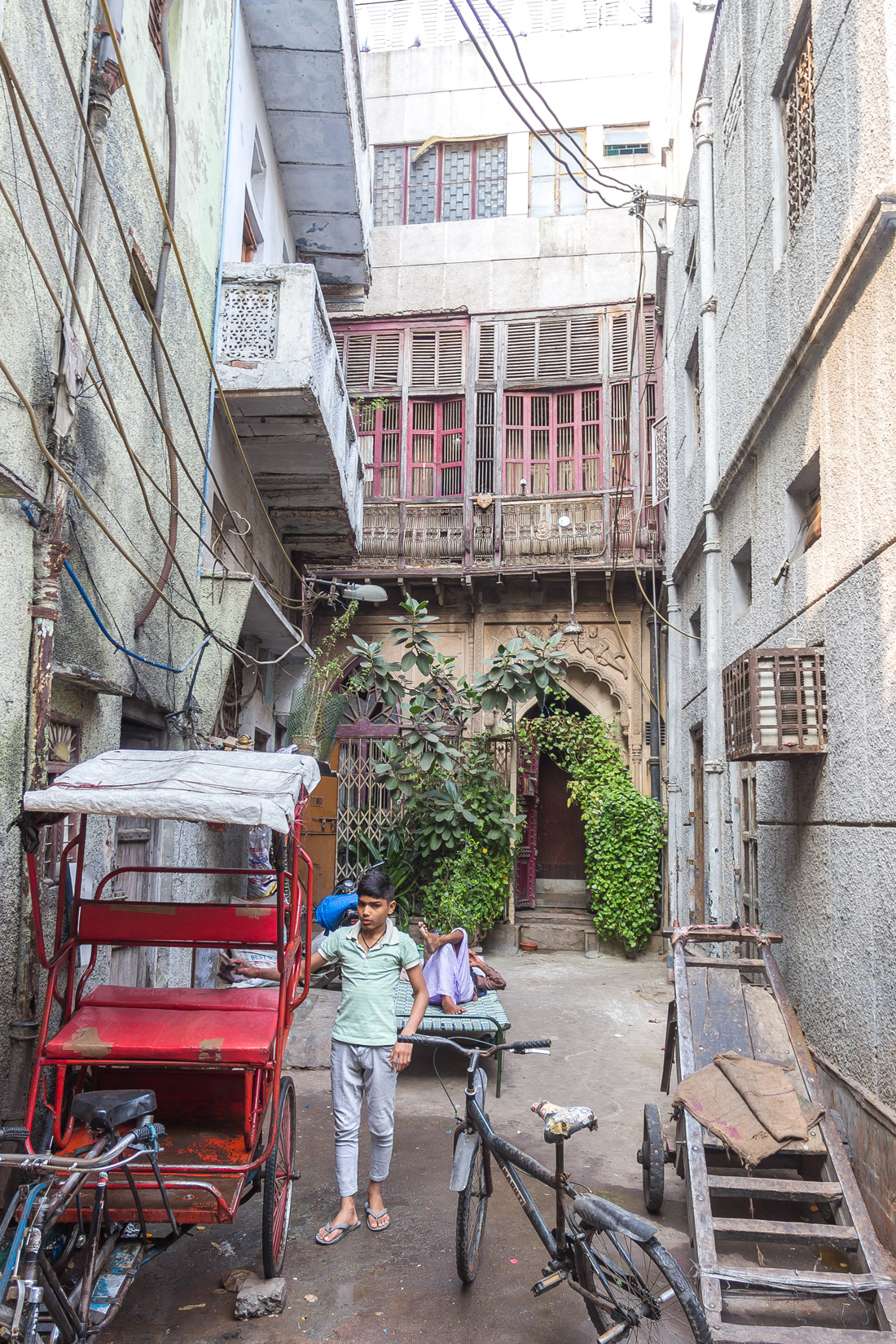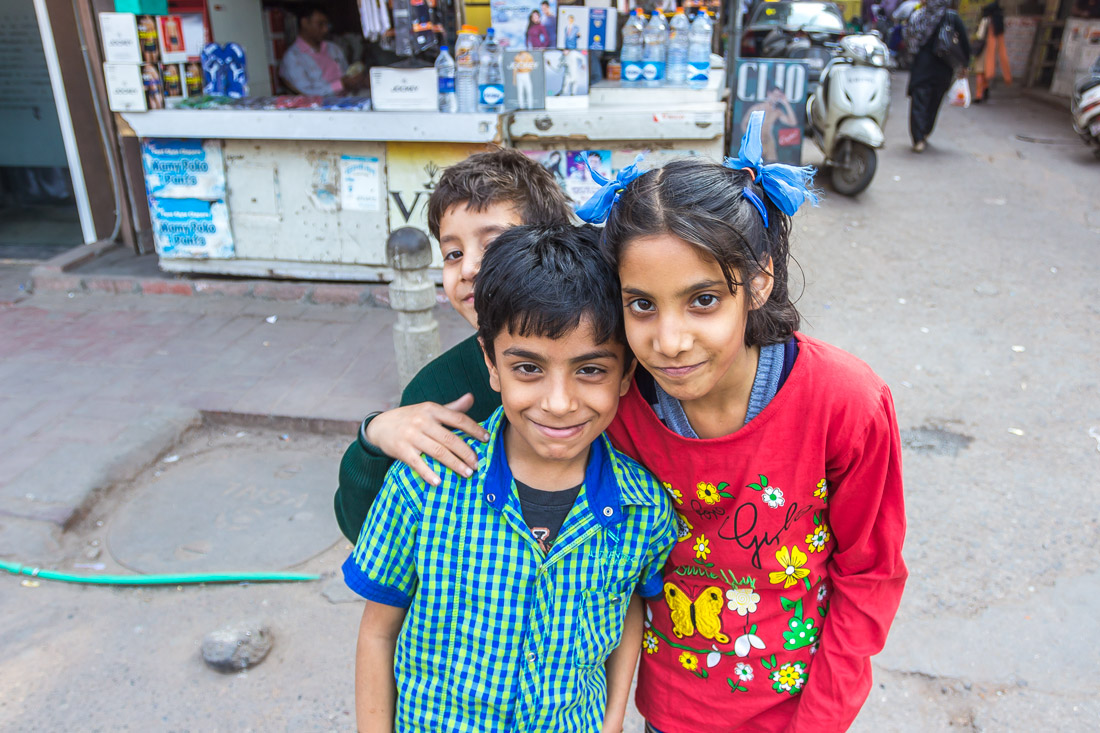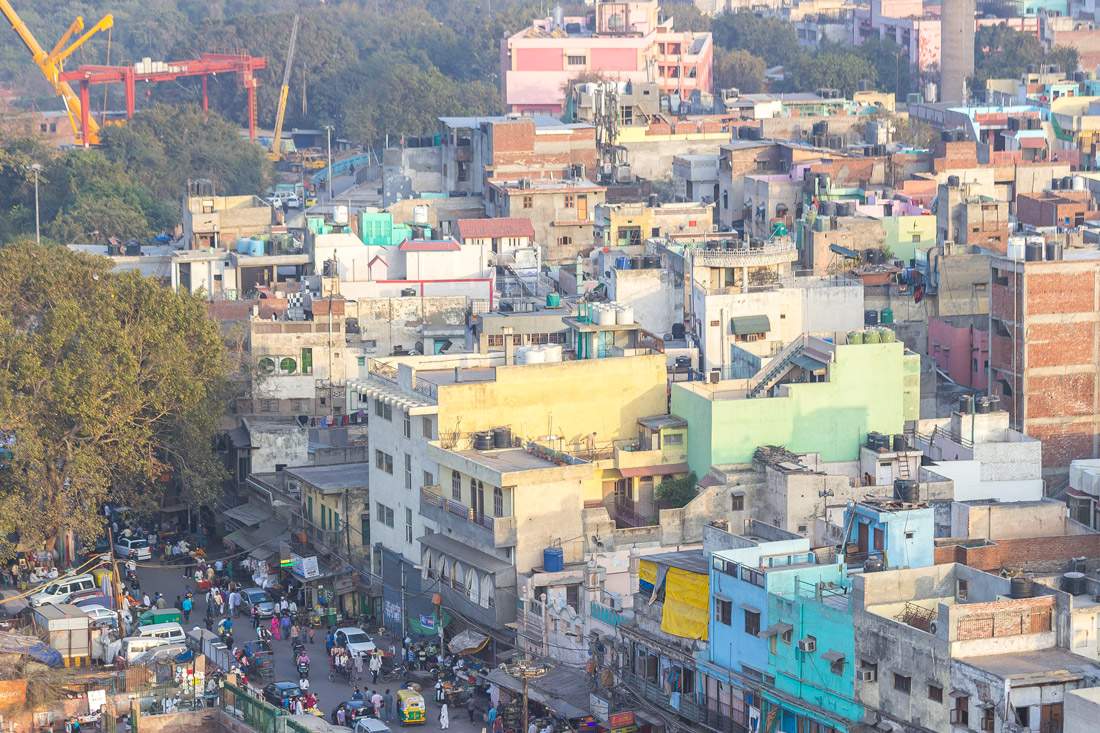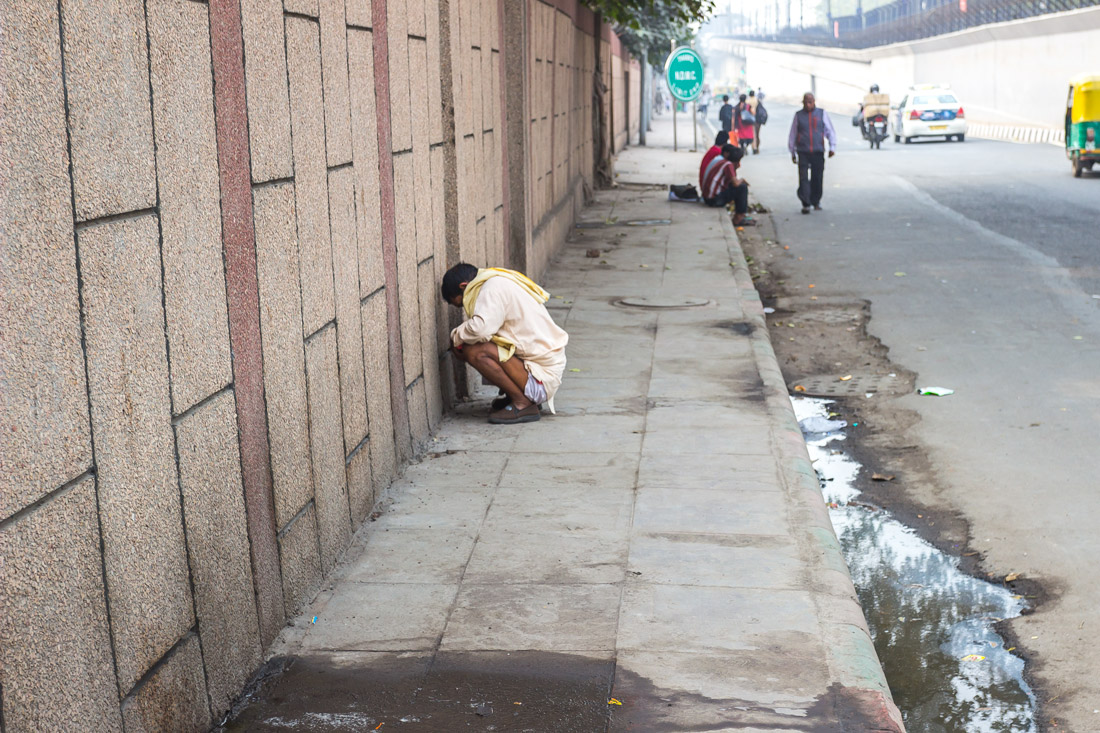Delhi. Part Two. Old City
I arrive in Delhi around 10 o’clock in the evening. It takes an hour for airport checks and the journey to the city center on the train. The sun sets in India at 6 o’clock in the evening all year round, so it’s already pitch dark outside, although the city is still awake.
The first desire that arises at night at New Delhi station is to escape somewhere. There’s an unimaginable, surreal chaos going on here. Around the station, there are crowds of people, every other person is a taxi driver or rickshaw driver who approaches persistently and tries to convince you for minutes to take a ride. All the cars constantly honk, all the people constantly shout. All this cacophony of sounds mixes with the announcements at the station, in between which a crazy “Ta-daaam!” can be heard.
The hotel is not so far from the station to pay for a dubious ride, but how do I get there? The road is blocked by this station, there seems to be an overhead crossing to the other side... oh, no, there’s a security guard and an X-ray machine for baggage check — probably for trains. You can break through into the station building through beggars, but even there, there is no passage, only ticket counters.
In fact, the security guard with the X-ray machine turns out to be a real overhead crossing to the other side, but who would have thought of that? I have to go around the station, taking a two-kilometer detour. Walking through the streets of Delhi at 11 o’clock at night, holding a smartphone in hand — quite an adventure. It’s worth gripping it tighter and putting on a serious face, speaking with a distinct Russian accent, so that no one even considers engaging with me.
Now it’s the other side of the station, and I have to make my way to the hotel, which is somewhere there, amidst dilapidated houses, not even all streets are marked. The address on the slip is highly informative: “Our hotel is located behind Revels Paharganj Hotel.” And it just rained. While the area near the station had asphalt, in these slums called Paharganj, which attract millions of tourists with their cheap hostels, my feet start squelching and slipping in some disgusting sludge that the dim lighting doesn’t allow me to see clearly.
The wide road is replaced by a narrow pathway, two or three meters wide, cutting through some houses, makeshift huts, poles wrapped with wires, laundry hanging from windows, and damn filth underfoot. Gripping my smartphone tightly to prevent anyone from snatching it out of my hands, I have to make my way blindly.
The last straw is the dog. It’s lying there, seemingly minding its own business. I walk past it and feel a light, charming bite on my leg. I turn around. It’s standing there, looking at me. It didn’t even break through my jeans, just gave a little nip as if to say, “Hey, you’re in India.” And then it goes about its own business.
Finally, the hotel.
I wake up in the morning and go outside. A typical street in the old city of Delhi. So, this is where I was walking at night.

Hanging laundry.

Amidst peeling walls, dust, makeshift parking, cables, and garbage, glass doors with a sign “Something Inn” suddenly emerge — and there’s a fairly decent hotel behind them. That’s how it is everywhere here. It looks good inside, and the exterior is passable.

There are indeed issues with wires in Asia.

Not always behind them can you see interesting artifacts. For example, this wonderful sign that says “Telephone.”

There are also problems with traffic on the street. In short, it’s impossible to walk.

The alleyways can be incredibly narrow.

You can turn the wrong way and end up in a dead-end. It would be unpleasant to stumble upon this place at night.

The doors of the houses. They are beautiful.



Not always, though.

But there is plenty of beauty to be found if you look closely.

And yet Paharganj is the tourist hub of Delhi. It tries to prove it with its whole appearance. It mimics either Tokyo or 1950s New York.

At night, everything is illuminated with neon lights.

It looks quite funny next to the neighboring Indian slums.

On the rooftops, makeshift laundromats are set up, of course.

About people in India, everything becomes clear when in the first ten minutes of being in Delhi, you hear someone speaking Russian with a distinct Indian accent behind you, asking, “Do you speak Russian?”
Due to the surprise, all warnings about talking to strangers vanish from your head. A clever Indian studying the Russian language made me sit with him in a café and check his exercise notebook. He turned out to be, of course, a guide, and as a gesture of gratitude, he escorted me to Qutub Minar and then left to join his tourists. He didn’t ask for money.

Gradually, you begin to understand that such behavior is completely normal here. It’s easy to get acquainted with anyone on the street and find yourself in adventures. Whether they are good or bad depends on your ability to judge people, but overall, aggression is minimal here. On the contrary, everyone is very friendly, constantly approaching to introduce themselves and take pictures together. Some want to be photographed while hugging a foreigner, while others ask to be photographed while working.
After getting to know India more closely, you realize that all the concerns were in vain. You can confidently walk through slums with a large camera and a smartphone navigator in hand without worrying, as no one will come running and snatch things from your grasp, as it may initially seem. In fact, it seems like almost every other local person here has a smartphone. The poor Indians, for the most part, engage in offering their unnecessary services and trying to get money for those services, but not engaging in blatant theft.
The most persistent ones are children. For them, encountering a foreigner with a camera is like catching a star from the sky. They always want to get into the frame and shake hands.

And, of course, beg for money. These kids followed me for about two kilometers. No matter how hard I tried to shake them off, weaving through sidewalks and roadways, attempting to disappear into the crowd, they would always catch up with me, block my path, and beg for ten rupees.

In the end, one particularly audacious kid unzipped the back pocket of my backpack and took something out of it. All valuable items were securely locked, while the back pocket contained only junk, so I didn’t pay much attention and continued walking. I was surprised when the little rascal caught up with me and returned the stolen napkins. Conscience had awakened after all.

In the Muslim part of Delhi, it’s the worst. Everything is stuck in one massive traffic jam.

Everyone finds their own way through. To walk properly, you have to push aside, for example, the wheels of cycle rickshaws, prevent cars from passing, jostle and jump over sacks of salt. Standing and waiting for others to let you through is pointless: they won’t let you.

All forms of Indian transportation pour onto the streets during rush hour: cars, rickshaws, bicycles, carts, cows — everything merges into one gigantic chaos along with the flow of people, making it impossible to walk. Once you enter this digestive tract, you remain in it for a long time, as there is no way out. You have to go with the flow for several kilometers.
Walking in such places is quite an experience!
At homes, on the ground floor of any house, there is a shop run by the residents of that house, a family business. They sell a variety of items, mostly food, water, and a mild stimulant called betel leaves, from which people spit out brown residue everywhere.

Beauty.

Local school.

Sidewalks.



In this area, I accidentally came across a mosque called Fatehpuri Masjid. It was nothing particularly remarkable, just a typical Indian memorial painted in lime color. I entered here to catch my breath after running through the buzzing streets. I took off my shoes and placed them aside, as is customary among Muslims, and sat by the fountain.
Two young worshippers approached me instantly:
“Hey, hello!”
“Hello. Is it okay if I sit here? I’m a Christian.”
“Yes, of course, feel free to sit. Islam is for everyone.”
“Where are you from?”
“Well, I’m from Russia.”
“Can I take a photo with you?”
“No problem.”
As the conversation progressed, other inhabitants of the mosque began to gather around me. More and more of them. Eventually, I was surrounded by about ten people, forming a closed circle of Muslims, diligently answering their various questions.
At first, I even tightened my backpack closer. In vain, of course. The guys turned out to be very friendly. They asked how I was doing, clarified if I was hungry, and offered me to embrace Islam. It turned out that they live and study near the mosque.
”Do you want to go upstairs?”
”Oh, can I?”
”Of course, let’s go.”
I would have never guessed on my own that it was possible to go up to the roof of the mosque. And I would have never imagined that I should turn into this inconspicuous alley, overgrown with food stalls, and climb the stairs to the very top, almost near the minarets.
From here, the dwellings of the old city can be perfectly seen.

A jumble of houses. They grow in a cascading manner, one extension after another. The top is crowned with water barrels.

Hanging laundry.

Someone lives on the roof.

The mosque is closely adjacent to an old spice market.

It is unclear what exactly belongs to the market: the three-story building, the self-built structure in the center, or only the area beneath them.

But there are definitely people living here.

In the distance, the Red Fort is visible — a famous landmark in Delhi. I’m taking this picture through a telephoto lens, explaining to the guys:
“This is specifically for capturing from a distance. Do you want to take a look?”
One person takes the camera and starts poking his finger at the viewfinder. At that moment, I was taken aback: is he seeing a camera for the first time? He seemed to have taken pictures of me on his phone earlier.
“You don’t use your finger here, but your eye.”
“Wow, the view is amazing.”
“Yeah. Listen, do you have a school here?”
“Yes, we receive education at the mosque.”
“What subjects do you study?”
“Sociology, religion, social studies.”
“What about mathematics and physics?”
“No, no, we don’t study those.”
The intonation betrayed disdain towards science.
Towards the end of the walk, for some reason, the guys didn’t allow me to take a picture with them, even though we took numerous photos embracing each other. No worries, I caught their friends from the roof. They all have smartphones and are on Facebook.

Not far away was another mosque — Jama Masjid. It is a well-known place in Delhi, an important landmark.
The level of money extraction here is off the charts. Initially, they offered an entrance fee of a whopping three thousand rupees. Of course, it was just a “misunderstanding,” and the price suddenly dropped to three hundred. Then the ticket seller earnestly pushes a mute tour guide, an elderly Muslim man who runs at an incredible speed through the mosque, showing what to photograph. After a five-minute sprint, he asks for additional money personally. Naturally, he doesn’t receive a penny from me.

Using the same ticket, I return to the mosque after the evening prayer and it turns out that for an additional fee, you can climb one of the minarets. Like this one.

The spiral staircase inside the minaret leads to a narrow platform, enclosed by an iron mesh. If you look closely, you can see a lightning rod on the dome.

There’s nowhere higher to climb in Delhi. From here, the Red Fort is entirely visible.

A string of Indian houses stretches all the way to the horizon.




From the mosque’s roof, it is also possible to have a good view of one of the adjacent streets and the crowd of people and rickshaws that engulf it.


Despite the all-encompassing chaos, most people on these streets are busy with their own affairs. Some are engaged in trading, for example.

Someone is repairing shoes.

Someone is brushing their teeth in the morning.

Someone is resting.

Someone is simply begging.

And someone is carrying food on their head.


By the way, speaking of food. Street food in India is extremely diverse: kebabs, rice, chapatis, flatbreads, puris, fruits.

The most common sellers are those of crispy fried balls called “pani puri”. The balls are empty inside. They can be dipped in sauce or filled with something for taste.

The woman is selling peanuts near the “Gateway of India” monument.

Certainly, all of this is prepared, to put it mildly, in non-sterile conditions.


They seem to fetch water from such columns.

Or they pour it first into tanks and then use it.

Food stall.

I don’t think it’s worth eating on the streets. Personally, I’ve only tried rice with beans and fruits. Moreover, fruits should be peeled, including apples. And it’s uncertain what they are grown on.

They usually trade with carts. It’s convenient: bring a cart loaded with fruits in the morning, place it in the middle of the road, and sell away. Take it away in the evening.

Because of these street vendors, it’s almost impossible to walk properly on the streets. They block both the sidewalk and half of the roadway.

Streets.


They sell not only food. The entire old city in Delhi is one big bazaar. It’s like if all the markets in Moscow: computer, household, plumbing, footwear, grocery, music, and others were combined into one large market and spread evenly throughout the city. It would result in one big bazaar.
That’s how it is in Delhi. Here you can buy absolutely everything: an iPhone, a television, a washing machine, a toilet, a carpet, a sofa, Crocs. You can buy and immediately go on a tour with all of this because tours are also sold at every step. There isn’t a single supermarket in the meantime.


In conclusion to the story about the sore point: surprisingly, public toilets are not uncommon in Delhi. Sometimes you come across such modern ones that Moscow could use.

But most often, the toilet is a brick enclosure with urinals right in the middle of the street.


Although it is not necessary for an Indian to relieve themselves. They piss right here, just like that. Some sit down.

True, not because they are shy. Just because of their garments.


